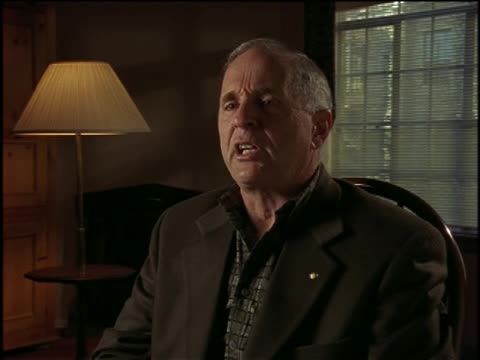NOVA; To the Moon; Interview with William "Bill" Anders, US Air Force Major general, engineer, astronaut, and Lunar Module Pilot on Apollo 8, part 3 of 3
- Series
- NOVA
- Episode
- To the Moon
- Producing Organization
- WGBH Educational Foundation
- Contributing Organization
- WGBH (Boston, Massachusetts)
- AAPB ID
- cpb-aacip-15-w950g3jf6c
If you have more information about this item than what is given here, or if you have concerns about this record, we want to know! Contact us, indicating the AAPB ID (cpb-aacip-15-w950g3jf6c).
- Description
- Program Description
- This remarkably crafted program covers the full range of participants in the Apollo project, from the scientists and engineers who promoted bold ideas about the nature of the Moon and how to get there, to the young geologists who chose the landing sites and helped train the crews, to the astronauts who actually went - not once or twice, but six times, each to a more demanding and interesting location on the Moon's surface. "To The Moon" includes unprecedented footage, rare interviews, and presents a magnificent overview of the history of man and the Moon. To the Moon aired as NOVA episode 2610 in 1999.
- Raw Footage Description
- Bill Anders, engineer, former NASA astronaut on Apollo 8, and retired US Air Force Major General, is interviewed about Apollo 8. Anders describes his feelings while looking at the Earth from the moon, as well as the intense photography regime that accompanied the mission and his inability to sleep. The mission also yielded some scientific information, but not as much as later expeditions. Although there were dangers to space flight, which were highlighted by the Apollo 1 fire, Anders did not feel it was any more dangerous than other missions, although his wife was worried because of their five children and lack of insurance. Anders ends with explanations of why he did not go on Apollo 13, what might have led to the explosion on Apollo 13, and what might have happened had the Apollo 13 crises taken place during Apollo 8.
- Created Date
- 1998
- Asset type
- Raw Footage
- Genres
- Interview
- Topics
- History
- Technology
- Science
- Subjects
- American History; Gemini; apollo; moon; Space; astronaut
- Media type
- Moving Image
- Duration
- 00:24:17
- Credits
-
-
Interviewee: Anders, William, 1933-
Producing Organization: WGBH Educational Foundation
- AAPB Contributor Holdings
-
WGBH
Identifier: cpb-aacip-24cf13b9579 (Filename)
Format: Digital Betacam
Generation: Original
Duration: 0:24:18
If you have a copy of this asset and would like us to add it to our catalog, please contact us.
- Citations
- Chicago: “NOVA; To the Moon; Interview with William "Bill" Anders, US Air Force Major general, engineer, astronaut, and Lunar Module Pilot on Apollo 8, part 3 of 3 ,” 1998, WGBH, American Archive of Public Broadcasting (GBH and the Library of Congress), Boston, MA and Washington, DC, accessed December 6, 2025, http://americanarchive.org/catalog/cpb-aacip-15-w950g3jf6c.
- MLA: “NOVA; To the Moon; Interview with William "Bill" Anders, US Air Force Major general, engineer, astronaut, and Lunar Module Pilot on Apollo 8, part 3 of 3 .” 1998. WGBH, American Archive of Public Broadcasting (GBH and the Library of Congress), Boston, MA and Washington, DC. Web. December 6, 2025. <http://americanarchive.org/catalog/cpb-aacip-15-w950g3jf6c>.
- APA: NOVA; To the Moon; Interview with William "Bill" Anders, US Air Force Major general, engineer, astronaut, and Lunar Module Pilot on Apollo 8, part 3 of 3 . Boston, MA: WGBH, American Archive of Public Broadcasting (GBH and the Library of Congress), Boston, MA and Washington, DC. Retrieved from http://americanarchive.org/catalog/cpb-aacip-15-w950g3jf6c
